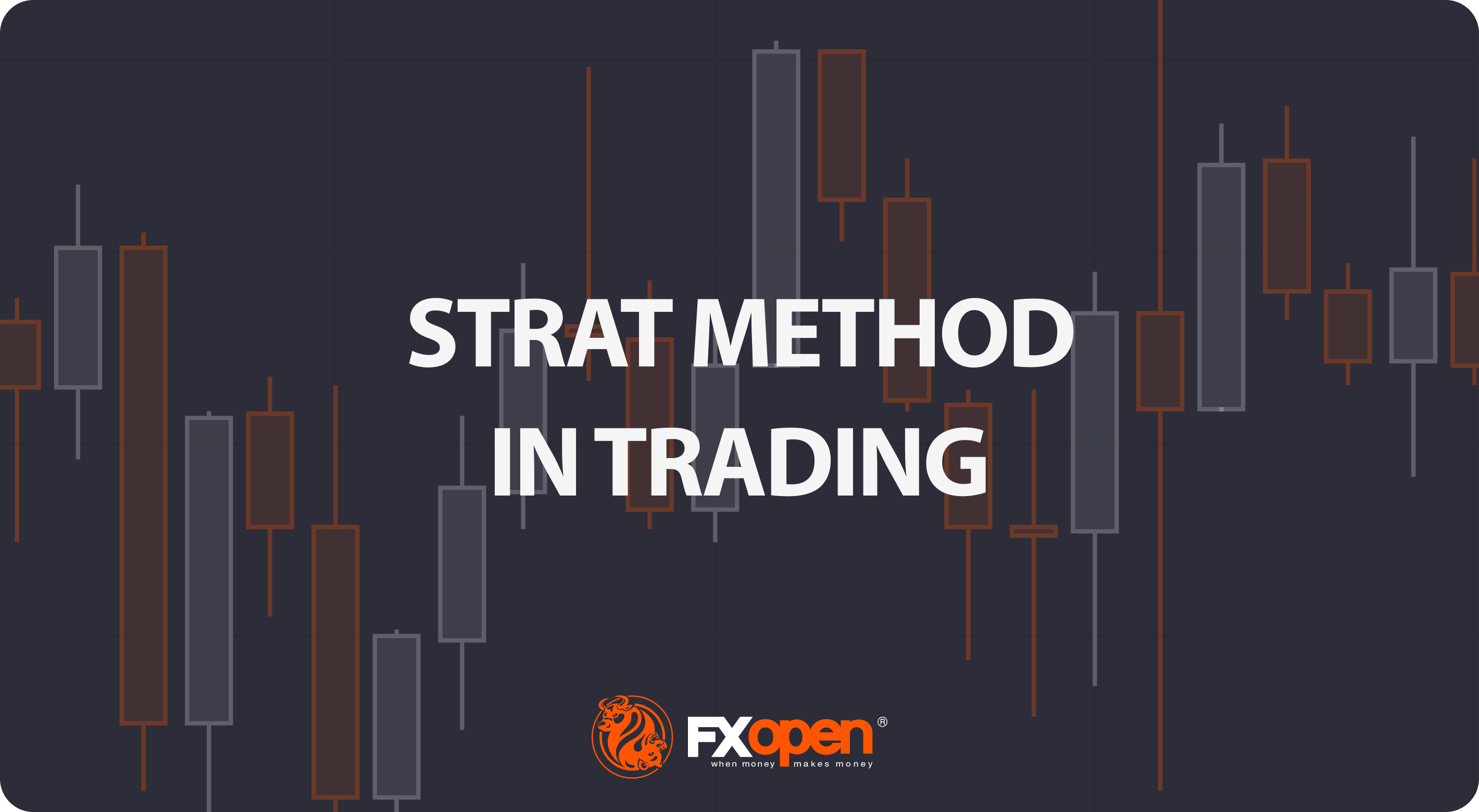How Can You Use the STRAT Method in Trading?

The STRAT method is a unique trading approach that is supposed to simplify market analysis by breaking price action into clear, actionable scenarios. Developed by Rob Smith, it focuses on candlestick patterns, scenarios, and timeframe alignment to help traders better understand market structure. This article explores the key components of the STRAT method, its practical application, and how it can potentially refine trading strategies.
What Is the STRAT Trading Method?
The STRAT method is a trading strategy created by Rob Smith. Its designed to simplify technical analysis by focusing on price action and breaking down market movements into clear, actionable steps. At its core, the STRAT strategy categorises price behaviour into three scenariosinside bars (1), directional bars (2), and outside bars (3)helping traders identify potential opportunities and understand the market structure.
One of the STRATs standout features is its emphasis on timeframe continuity, where traders examine how price movements align across different timeframes, such as daily, weekly, and monthly charts. This alignment helps traders gauge the broader market direction, potentially improving their analysis.
The STRAT trading method also uses specific candlestick patterns to signal potential reversals or continuations. For example, an inside bar (Scenario 1) indicates price consolidation, often preceding a breakout. A directional bar (Scenario 2) suggests trending movement, while an outside bar (Scenario 3) reflects heightened volatility by capturing both higher and lower price ranges.
Unlike some trading approaches that rely heavily on indicators, the STRAT focuses on raw price action, giving traders a clearer, no-nonsense view of market dynamics. Its an accessible and structured way to analyse charts and make decisions based on what the market is doing right now.
Key Components of the STRAT Trading Strategy
The STRAT trading strategy stands out because of its straightforward approach to breaking down price action. As mentioned above, inside bars, directional bars, and outside bars are central scenarios. These scenarios categorise how the price behaves within a given timeframe, providing a framework for traders to interpret the market. Lets delve into each component in detail.
Scenario 1: Inside Bar
An inside bar forms when the current candlestick's high and low remain within the range of the previous candlestick. In other words, the market is consolidating, showing no breakout beyond the prior candles extremes. Traders often interpret this as a pause or a moment of indecision in the market.
What makes inside bars significant is their potential to precede larger price movements. For example, after a series of inside bars, a breakout often occurs when the price breaks above or below the consolidation range. While this pattern alone doesnt confirm direction, it signals the market is storing energy for a potential move.
Scenario 2: Directional Bar
A directional bar, also called a 2 in STRAT terminology, occurs when the price breaks either the high or low of the previous candle but not both. This creates a clear directional moveeither upward (2 up) or downward (2 down).
These bars are essential because they indicate that the market has picked a direction. A 2 up shows bullish momentum, while a 2 down signals bearish activity. These movements are especially useful when aligned with other factors, such as larger trends or support and resistance levels.
Scenario 3: Outside Bar
The outside bar is the most volatile of the three. It forms when the current candlestick's high exceeds the previous candles high, and its low breaks below the previous low. Essentially, the price covers both sides of the prior range, capturing significant market activity.
Outside bars often suggest a battle between buyers and sellers, leading to volatility. These bars can provide insights into reversals or continuing trends, depending on their context within the broader market structure.
Expanding and Contracting Markets
The STRAT method also places significant emphasis on understanding the expanding and contracting market phases, which offer critical insights into market dynamics. These phases reflect shifts in volatility and price behaviour, helping traders interpret broader market conditions.
Expanding markets occur when price action creates both higher highs and lower lows compared to previous bars or ranges. This phase often signals heightened volatility as buyers and sellers battle for control, creating larger swings. Scenario 3 (outside bars) typically appears during this phase, capturing the markets attempt to push in both directions. Expanding markets can provide potential opportunities for traders who are prepared to navigate rapid price movements.
Contracting markets, on the other hand, are characterised by shrinking ranges, with lower highs and higher lows. This consolidation phase often results in inside bars (Scenario 1) and suggests indecision or reduced momentum. Traders frequently watch for potential breakouts as the market transitions out of contraction.
Combining Scenarios and Context
Ultimately, there are many combinations of these bars under the STRAT method (seen in the STRAT cheat sheet above), each with names like the 3-2-2 Bearish Reversal, 2-2 Bearish Continuation, 1-2-2 Bullish Reversal, and so on. For traders new to this system, it might be easier to start with a handful of patterns and practice them before adding others to their arsenal.
Some of the basic starting patterns include:
- 2-1-2 Reversal
- 3-1-2 Reversal
- 2-1-2 Continuation
- 2-2 Continuation
However, each of these scenarios becomes even more meaningful when paired with other market data, such as higher timeframes or candlestick structures. For instance, patterns like hammers or shooting starts often emerge within these scenarios, offering specific signals to traders.
Explore these scenarios and their combinations with live charts in FXOpens free TickTrader platform.
Timeframe Continuity: A Core Pillar
Timeframe continuity is a fundamental aspect when interpreting the STRAT candle patterns, offering traders a way to align their analysis across multiple timeframes. Its about ensuring that the price action on smaller timeframes complements whats happening on larger ones. When all timeframes agree, it can provide a clearer picture of market direction and potentially improve the decision-making process.
In practice, traders using the STRAT in stocks, forex, commodities, and other assets often look at three primary timeframes: the daily, weekly, and monthly charts. Each represents a piece of the puzzle. For example, if a trader sees a bullish Scenario 2 (directional bar) on the daily chart, but the weekly chart shows a bearish pattern, this misalignment might signal caution. However, when the daily, weekly, and monthly timeframes all show bullish directional movement, it creates a stronger case for a trend continuation.
Timeframe continuity also helps traders filter out noise. Shorter timeframes, like the 15-minute or hourly charts, can produce conflicting signals, leading to overtrading or confusion. By focusing on the larger timeframes first, traders can ground their analysis in broader market trends and avoid reacting impulsively to minor fluctuations.
Practical Application of the STRAT Method
Applying the STRAT method involves a systematic approach to analysing charts and identifying potential opportunities. While every trader may adapt the method to their own style, the process generally follows a logical flow. Heres how it can be broken down:
Step 1: Understanding the Current Scenario
Traders typically start by identifying the active scenario (1, 2, or 3) on their chosen timeframe. This initial classification helps to set the context. For instance, in the EUR/USD daily chart above, we initially see an outside bar (Scenario 3), followed by two inside bars (Scenario 1)a 3-1-1 Bullish Reversal pattern; this transitions into a 1-2 Bullish Reversal before a 2-2 Bullish Continuation. In other words, the market is seen as entering a bullish phase.
Step 2: Aligning Multiple Timeframes
The next step involves assessing how the current scenario fits within the larger market structure by checking higher timeframes. In the EUR/USD example, the monthly chart shows three consecutive bullish directional bars (Scenario 2), also known as a 2-2 Bullish Continuation. This is supported by the weekly chart. Initially, there are two bearish directional bars before a bullish outside bar (Scenario 3) and a bullish directional bar. This indicates an alignment of bullish momentum, indicating a higher probability for the daily chart setup.
Step 3: Identifying Supporting Patterns and Signals
Within the scenario, specific candlestick patterns, like hammers or shooting stars, alongside key support and resistance levels, often provide additional context. These signals are believed to be more effective when they align with the broader market direction and timeframe continuity.
In the EUR/USD example, the weekly chart shows a candle resembling a hammer (the outside bar), while the daily chart shows a pattern resembling a Three Stars in the South formation (the 3, 1, 1 candles). While rare, the three stars in the south pattern can signal sellers are losing momentum, when:
- The first candle features a long body and long lower wick
- The second candle has a shorter body and closes above the first candles low
- The third candle has another short body with minimal wicks and a range inside the second candle.
While both formations dont meet the technical criteria for their respective patterns, a trader might consider them to add weight to the bullish idea. The weekly chart also shows the price breaking past a previous resistance level, which adds confluence.
Step 4: Entering and Exiting
A trader would typically enter as the candle on their chosen timeframe closes. A stop loss could be set beyond the entry candle or a nearby swing high/low. Some traders prefer to close the position depending on the next candle close and corresponding scenario, while others might target a particular support/resistance level or use multi-timeframe analysis to find a suitable exit point.
Advantages and Challenges of the STRAT Method
The STRAT method offers a unique, structured approach to trading, but like any strategy, it comes with both advantages and challenges. Understanding these can help traders decide how to integrate it into their approach.
Advantages
- Clarity in Analysis: By categorising price action into simple scenarios, the STRATs patterns simplify market behaviour, reducing ambiguity.
- Focus on Price Action: The method relies on raw price data rather than indicators, offering a direct view of market dynamics.
- Adaptability Across Markets: Whether trading equities, forex, or commodities, the STRAT applies universally to any market with candlestick data.
- Improved Consistency: Its rules-based framework helps traders avoid impulsive decisions and stay aligned with their analysis.
Challenges
- Learning Curve: Understanding the nuances of scenarios and timeframe continuity requires time and practice.
- Patience Required: Waiting for alignment across multiple timeframes may lead to fewer trade opportunities, which may frustrate active traders.
- Context Dependency: While structured, the STRAT still requires interpretation, and outcomes depend on how well traders incorporate broader market factors.
The Bottom Line
The STRAT method offers traders a structured way to analyse price action, combining scenarios, candlestick patterns, and timeframe continuity to navigate markets with confidence. While it requires discipline to master, its clear framework can potentially improve decision-making.
Ready to apply the STRAT method? Open an FXOpen account today and start exploring potential opportunities this trading approach can offer across more than 700 markets with competitive trading conditions, including low commissions and tight spreads.
FAQ
What Is the STRAT Strategy by Rob Smith?
Rob Smith developed the STRAT strategy, a trading method that simplifies technical analysis by categorising price action into three STRAT candle scenarios: inside bars, directional bars, and outside bars. It focuses on understanding market structure, using timeframe continuity and actionable signals to interpret trends and reversals.
What Is the STRAT Method of Trading?
The STRAT method is a rules-based approach to trading that prioritises price action over indicators. It uses specific candlestick patterns and scenarios to identify potential trading opportunities and aligns multiple timeframes to provide a cohesive market view.
What Is a Rev Strat?
According to Rob Smith, a rev strat refers to particular setups. First is a 1-2-2, initially with an inside bar, then a directional bar in one direction, and finally a directional bar in the opposite direction, marking a possible reversal. The second is a 1-3 setup, with an inside bar followed by an outside bar. This signals an expanding market in the STRAT, meaning a period of heightened volatility, and is considered bullish or bearish based on the outside bars direction.
Read more: https://fxopen.com/blog/en/how-can-you-use-the-strat-method-in-trading/
Text source: Forex Trading Blog










